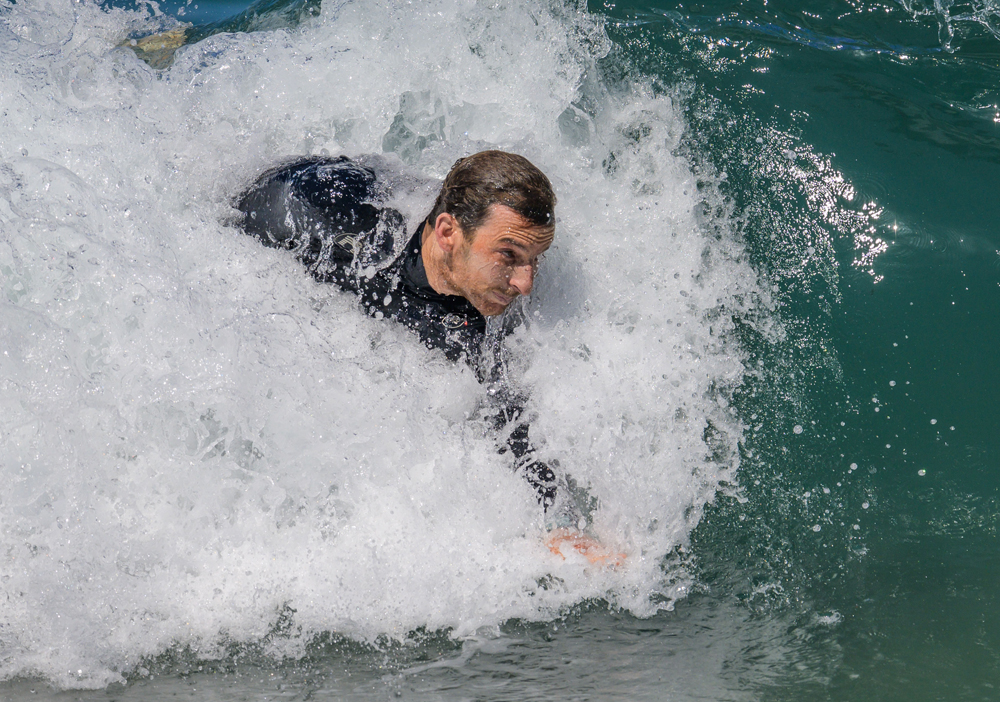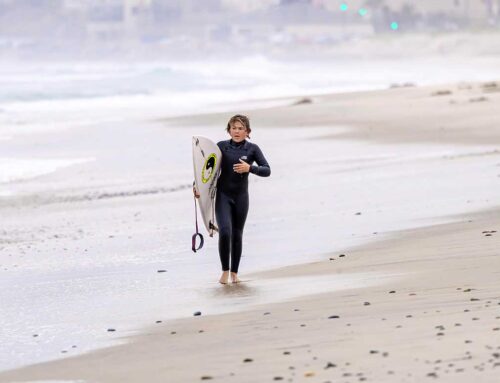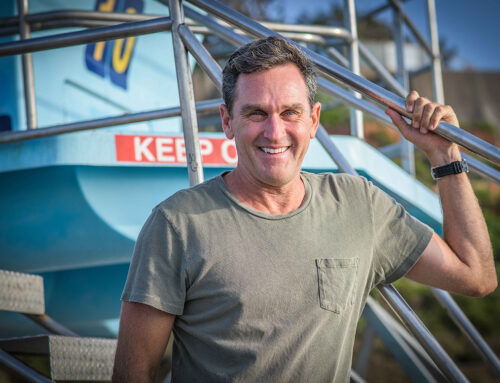Interviewed and photographed by Nicholas Paoni
The amount of surfing talent in the Encinitas Board Riders Club is well known and pretty awesome. The roster includes a Hall of Fame rider, current pros and a stable of amazing young rippers that will keep the club a force to be reckoned with in competition for many years to come.
Amazingly, the club also boasts an usually high concentration of world class surf photographers. The “In Focus” series will give these super shooters, who are also accomplished riders, an opportunity to share with you how their love of the ocean has developed into a life-long love of surfing and fueled successful careers documenting the sport and its extraordinary personalities.
Leading off the series is Todd Glaser. Todd is a product of San Diego who has made good. I mean really good. He got his start as a staff photographer for Surfer Magazine and his work appears on several covers. He didn’t stop there though. You can also find his shots published by The New York Times, Outside, GQ, and Mens Health. His work can also be viewed in the permanent collection of the Smithsonian’s National Portrait Gallery in Washington, DC, an honor that will likely distinguish him from other contemporaries in the field.
I met Todd at Seaside Reef State Beach for an interview and photo shoot and here is what he had to say.
N. Hi Todd and thanks for taking the time to chat with me about two of your passions, surfing and photography.
N. So which came first, surfing or photography?
T. Surfing came first. I fell in love with the ocean first. I think my passion and love of the ocean came before photography.
N. How did you learn photography?
T. At the beginning I was self taught. A friend of mine had a camera and a water housing he would always bring down to the beach and we would take turns shooting photos. I really didn’t know a whole lot about the technical side of photography, but I was already somewhat familiar with the ocean and waves. So there was a lot of trial and error for the first several years of photography. After I finished high school I took two years off, then I enrolled up in Santa Barbara in the Brooks Institute of Photography. That’s where I learned all the technical sides of photography.

N. You have done a lot of work with Rob Machado and you are good friends. How long have you known him and how did you meet?
T. Rob and I first met through his cousins. I went to school with his cousins from middle school on, and I would always hang out at their house and Rob would be over at their house. I first met Rob I think when he was baby sitting. Once I started coming up to Seaside, at maybe 12 or 13, I would see him at the beach all the time. We kind of knew each other peripherally really early on, like through middle school. As I got more and more into photography I would ask him “hey ya wanna go shoot photos” and I would think he would never say “yes” and then he’d be like “sure” and I’m like if Rob’s cool to shoot photos then everything is good. So funny enough Rob is one of the first guys I learned to shoot surfing photos with. Now we’ve become very good friends since.
What I love about Rob is he’s a surfer, of course, and he’s such a great collaborator and an artist himself, he’s a photographer, and so Rob is just a great collaborator.
N. You are also good friends with Kelly Slater and you have a book together. Can you tell me a little about that.
T. I was first introduced to Kelly by a mutual friend, Steve Sherman. It was in a parking lot in France. Sherm was following him for the European leg of the event and I was in France working on a surf film project, and they were in the parking lot. Kelly had just come back from Scotland and had maps of all the golf courses and the reef breaks outside the golf courses and Sherm was like “come on over I want you to meet someone”. Kelly and I had met once before, but Sherm was the one who really introduced us, and from the first trip that we did together we made a connection. We got along really well. He’s been a really good friend to our family, he’s an extension of our family too.
So the book is a collection of 15 plus years of traveling the world together, sharing rooms, some of the adventures we had, the world titles he’s won, some of the Pipe Masters he’s won. I kind of call it chronicles from a room mate, cuz a lot of times we’re sharing a room. We call it a Life of Waves and it’s a celebration of Kelly’s, both of our passion for waves, traveling, and my passion for photography and documenting it all. It’s in a hard back book and it comes out October 1st.
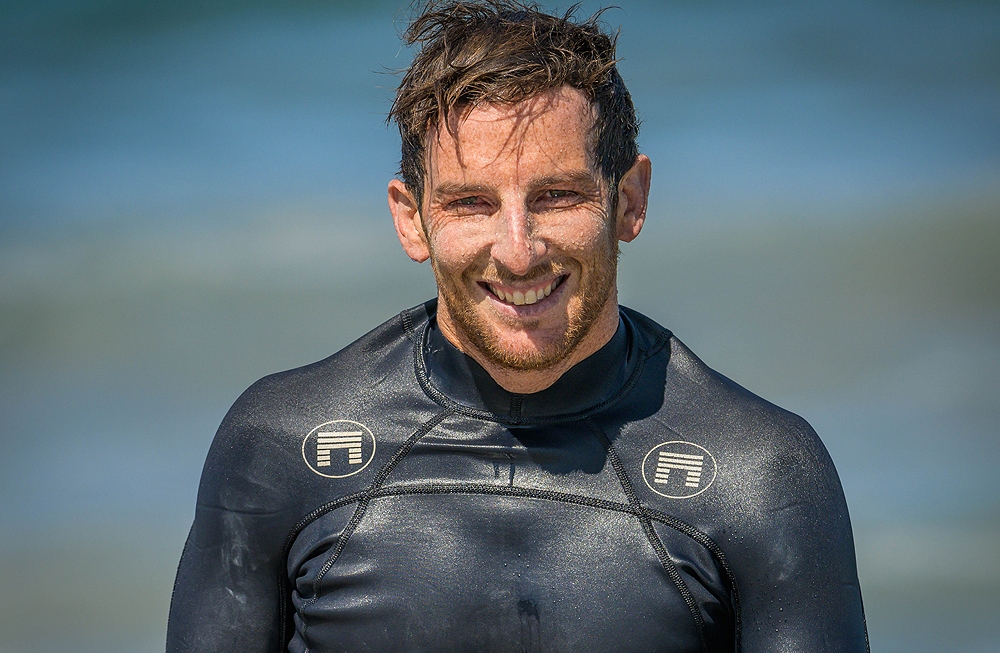
N. A lot of your work is in the water. What is it like being out there in the thick of the action and having a rider literally come barreling at you?
T. It’s fun, I love shooting photos in the water. It’s funny, my two passions with photography are water photography and portraiture. I’m a surf dog, when I’m not shooting I’m usually in the water surfing or body surfing. I spend as much time as I can in the water. So to have my camera be an extension of the way that I see surfing, it’s fun. There are times when the light’s good and I’m photographing a surfer and they are surfing very well, and I feel like my photos are surfing vicariously through the subject. There’s been times when my photos are as stylish as a Rob Machado, or as competitive as a Kelly Slater, and everyone in between.
It’s fun to approach surf photography, water photography, like you’re making a portrait, but you’re doing it in the water. So it’s kind of like a concert where a lot of people when they photograph a concert they photograph the first three songs and that’s it. I’m more the guy on stage shooting from back behind the drummer trying to show the world what it’s like to be surfing at its highest level, but from a unique point of view.
N. Have things ever gone sideways for you out there such that you felt afraid or were in trouble?
T. Yes. The ocean is a beautiful place, but it can also be very terrifying, and I do my best to prepare both physically and mentally for whatever the ocean may throw at us. You have to use your best judgement and past experiences to where you feel comfortable putting yourself in the lineup. Sometimes accidents happen and you just have to best prepare for the situations. Shooting in the water is very much an assumption of risk, so I try to limit my risk by being selective in which waves I totally commit on, and where I place myself in the lineup. I also try to limit my risks so if accidents happen I try to stay calm. It’s all about having a healthy life style and being prepared.
N. This is one of those questions that almost always comes up in an interview with a photographer, but what’s in your camera bag?
T. I’m not really a gear guy, but for some reason my kit is all over the place. My daily user for shooting still photos is a Cannon R5 or a 1DX Mark II. Most recently I’ve been using this Fuji GFX 100S which is a medium format camera. I’ll use that out in the water, it takes stunning, super high resolution images. That camera kinda got me excited about shooting. But it’s tricky cuz it’s a much slower process and there are a lot more opportunities to miss a shot than get the shot, but when you get it, it comes out really good. I use a wide variety of lenses, anything from a 10mm to a 500mm lens, quite a bit of gear.

N. Stills or video; which do you do more of, and do you have a preference?
T. I prefer to shoot stills, underwater stills are probably my favorite thing in the world to shoot. I wish we could shoot more of them around here, but the water isn’t as clear as we would hope. If I could choose what to shoot, I would shoot underwater images more than any other style of photography. Video, I enjoy, but I’m a terrible editor. I don’t mind shooting motion, but I usually pass the footage off to an editor.
N. The pandemic was hard on all of us. During lockdown some professionals were able to successfully work from home. That isn’t possible for a photographer who has to travel and be around people all the time. What did you do to survive personally and professionally?
T. During the pandemic there were a lot of people spending time at home. For whatever reason we were lucky and ended up doing quite a few photographic prints for people’s homes and offices, as people were taking that time to remodel and slow down and see that they had space on the walls. That really helped us professionally to get through the pandemic.
Health-wise we got through it OK, fortunately. At that moment it was just really nice to have that time with my family and slow down. I’d been probably doing 200 days on the road for over a decade. I surfed a little bit. We rode bikes a little bit. My wife and I, fortunately, we were in a position where we had our basic needs met and so we were able to spend that time together, slow down and make puzzles and we got on the sour dough kick like everybody else. But it was scary for a lot of people with so much unknown.
It was harder to get readjusted to doing the first shoot. I ended up working on a couple productions during COVID, which was a really big challenge. We had to have COVID tests daily on set. There was a whole other layer of production for commercial shoots and that was a challenge.
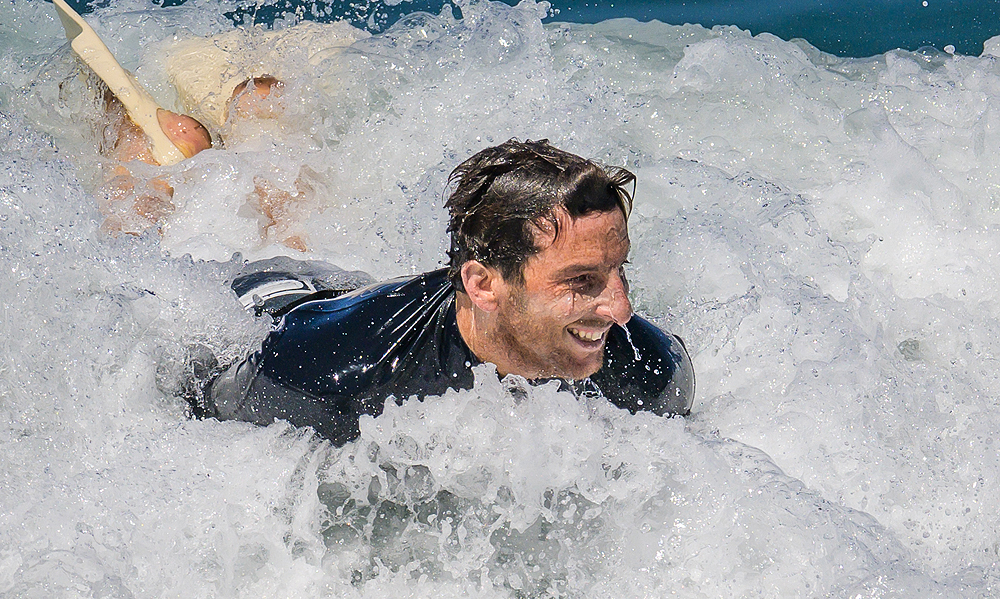
N. Do you ever shoot just for the fun of it, and if so, what do you photograph?
T. All the time. I hope you can see in my work that there is no difference between my personal work and my professional work, it really is all kind of one in the same. I have a very fortunate situation that people support the way that I like to see the world, and I like to see surfing, and I like to photograph people. My personal work and my professional work are very similar. It’s like when I’m home I love just photographing empty waves. That’s what I love to do more than anything else. For me photography is more about capturing light than it is about anything else. So If I’m home and the light is good I’ll be out shooting photos really early in the morning. Sometimes these evolve into prints that hang in galleries or in people’s homes. If I’m out on a surfing trip, I’m out just doing the same thing.
N. Do you do anything to unwind that doesn’t involve the ocean or photography?
T. Most recently I got into running, so I’ve been running a couple times a week, but I always end up jumping in the ocean after. My wife and I, we both ride bikes, so we’ll go mountain biking. I’d say a cross between mountain biking and running and making sour dough. But making sour dough is more stressful. For me it’s more stressful than anything else. There’s not a day goes by that I don’t think about looking at the ocean or jumping in the ocean.
N. What are your thoughts on AI and photography?
T. I haven’t really used it yet. I haven’t looked into it too much. I’ve seen a couple photographers that have used it as part of their artistic expression, but personally I haven’t tried it yet, and I’m not too interested in it.
N. You’ve had an incredibly successful career so far. Going forward, are there any additional goals or aspirations that you have for your work?
T. I think I want to continue to capture new images, and tell stories, and be able to share interesting stories with human interest elements. I think there are certain goals that I’ve always tried to achieve. Some of them I have, like there was a time when my goal was to get a photo in Surfer Magazine, and I did that. Then my goal was to get a cover, and I did that. The goal is kind of a catalyst to get out of the house and motivate, but the process is what you remember more than the actual end result.
N. What advice do you have for the next generation of surf photographers?
T. I would fall in love with the ocean first. In order to really capture surfing well you need to really enjoy the ocean. You also have to have a point of view, an opinion on what it is that you are capturing. Enjoy the time in the ocean. It is equally important to put the camera down and enjoy the waves. If you always have a camera you are somewhat disconnected from what is really happening because you are so focused on the camera, the lens, the exposure, the light, all the different settings that make for a great image. You need to put the camera away at times and be a surfer and observe and watch so the next time you bring a camera out you are seeing it from a different point of view.
N. Thanks again Todd, it’s been a pleasure talking with you and good luck on your book.
The transcript has been edited for brevity.



